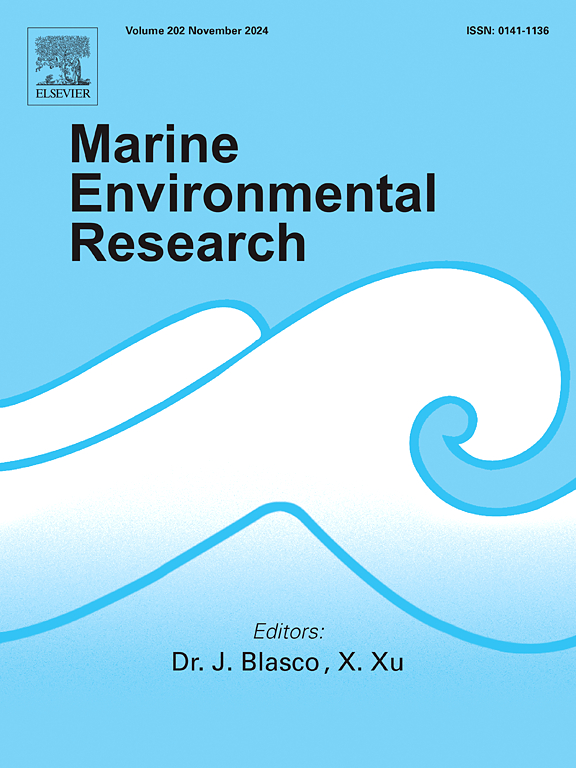Unveiling growth and carbon composition of macroalgae with different strategies under global change
IF 3
3区 环境科学与生态学
Q2 ENVIRONMENTAL SCIENCES
引用次数: 0
Abstract
Marine macroalgae ecosystems are increasingly recognized as potential contributors to carbon sequestration within blue carbon strategies. This study investigates how the carbon storage capacity of two macroalgal species with different living strategies, Fucus vesiculosus (k-strategy, slow-growing) and Ulva lactuca (r-strategy, fast-growing), respond to the individual or combined impacts of two drivers of global change, eutrophication and marine heatwaves. Differences in growth, biomass and carbon accumulation were assessed after 7 and 14 days in two experiments (field and laboratory) that tested different combinations of nutrient enrichment (increase nutrient/surface area of 1 g/cm2 in the field experiment and a concentration of 10 ml/l of Provasoli solution in the laboratory) and warming (5 °C increase) treatments. Results revealed that nutrient addition treatments had significant effects, reducing carbon incorporation by up to 22.5 % in F. vesiculosus compared to control. This reduction was particularly evident in the field experiment, suggesting that eutrophication negatively impacts the carbon storage potential of this slow-growing species. However, F. vesiculosus demonstrated greater resilience in maintaining biomass stability, whereas U. lactuca exhibited reduced growth and carbon accumulation under natural conditions. These findings highlight species-specific differences in carbon assimilation and biomass composition among macroalgae, which can influence their potential contribution to carbon cycling and storage in marine ecosystems, shaped by their ecological and physiological traits, and emphasize the importance of nutrient management for optimizing blue carbon storage. This research contributes to our understanding of macroalgae's role in climate mitigation and underscores the need for targeted conservation strategies to enhance their ecosystem services.

揭示全球变化下不同策略的大型藻类生长和碳组成
在蓝碳战略中,海洋大型藻类生态系统越来越被认为是碳固存的潜在贡献者。本研究探讨了两种不同生存策略的大型藻类——墨角藻(k策略,慢生长)和乳酸藻(r策略,快速生长)的碳储存能力如何响应全球变化的两个驱动因素——富营养化和海洋热浪的单独或联合影响。两个试验(田间和室内)分别在7天和14天后对生长、生物量和碳积累的差异进行了评估,试验采用不同的营养物富集组合(田间试验增加营养物/表面积1 g/cm2,室内Provasoli溶液浓度为10 ml/l)和升温(增加5°C)处理。结果表明,添加养分处理对水疱f的碳掺入有显著影响,与对照相比,减少了22.5%。这种减少在田间试验中尤为明显,这表明富营养化对这种生长缓慢的物种的碳储存潜力产生了负面影响。然而,在自然条件下,囊泡菌在维持生物量稳定性方面表现出更强的恢复力,而乳蓝菌则表现出生长和碳积累的减少。这些发现突出了大型藻类在碳同化和生物量组成方面的物种特异性差异,这些差异可能影响它们在海洋生态系统中碳循环和碳储存的潜在贡献,并强调了营养管理对优化蓝碳储存的重要性。这项研究有助于我们了解大型藻类在减缓气候变化中的作用,并强调了有针对性的保护策略以增强其生态系统服务的必要性。
本文章由计算机程序翻译,如有差异,请以英文原文为准。
求助全文
约1分钟内获得全文
求助全文
来源期刊

Marine environmental research
环境科学-毒理学
CiteScore
5.90
自引率
3.00%
发文量
217
审稿时长
46 days
期刊介绍:
Marine Environmental Research publishes original research papers on chemical, physical, and biological interactions in the oceans and coastal waters. The journal serves as a forum for new information on biology, chemistry, and toxicology and syntheses that advance understanding of marine environmental processes.
Submission of multidisciplinary studies is encouraged. Studies that utilize experimental approaches to clarify the roles of anthropogenic and natural causes of changes in marine ecosystems are especially welcome, as are those studies that represent new developments of a theoretical or conceptual aspect of marine science. All papers published in this journal are reviewed by qualified peers prior to acceptance and publication. Examples of topics considered to be appropriate for the journal include, but are not limited to, the following:
– The extent, persistence, and consequences of change and the recovery from such change in natural marine systems
– The biochemical, physiological, and ecological consequences of contaminants to marine organisms and ecosystems
– The biogeochemistry of naturally occurring and anthropogenic substances
– Models that describe and predict the above processes
– Monitoring studies, to the extent that their results provide new information on functional processes
– Methodological papers describing improved quantitative techniques for the marine sciences.
 求助内容:
求助内容: 应助结果提醒方式:
应助结果提醒方式:


